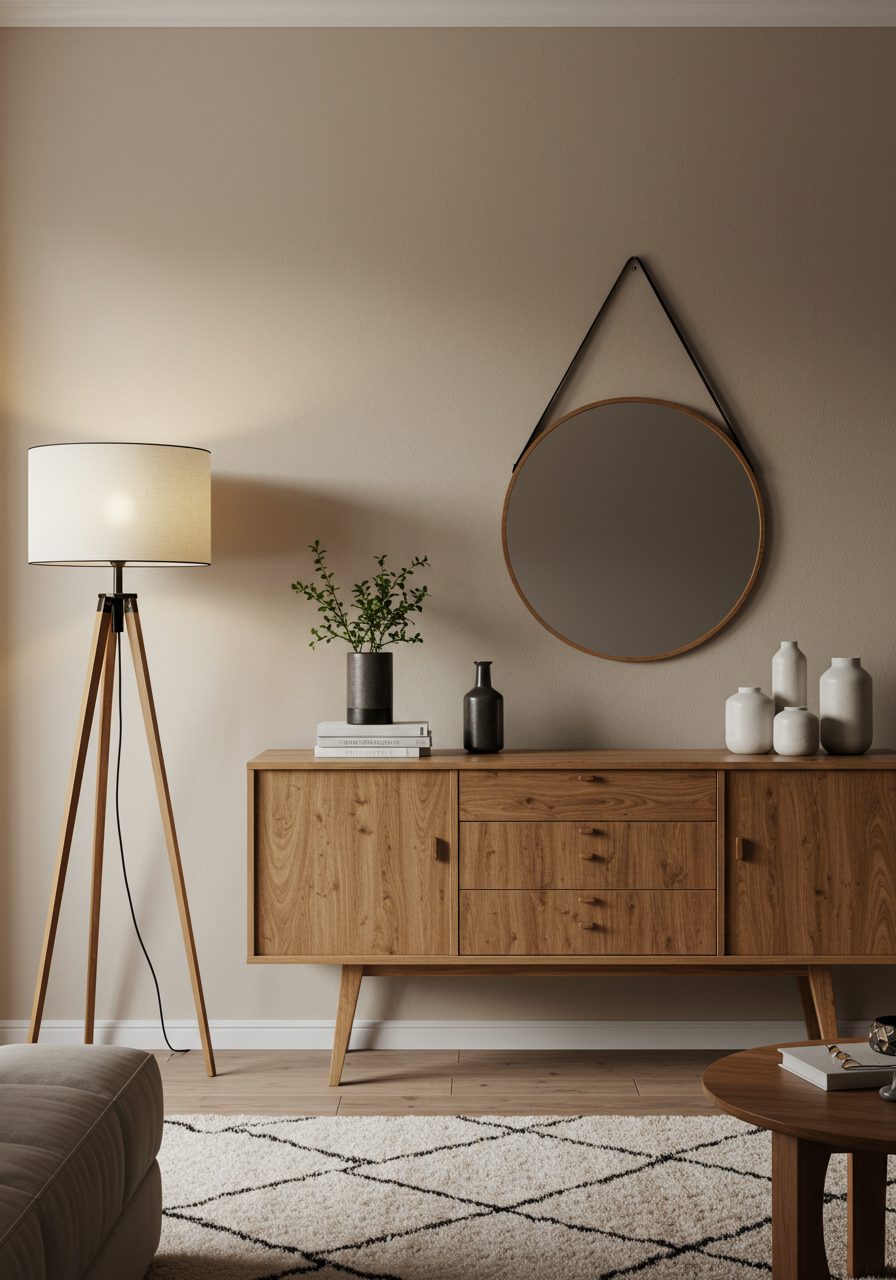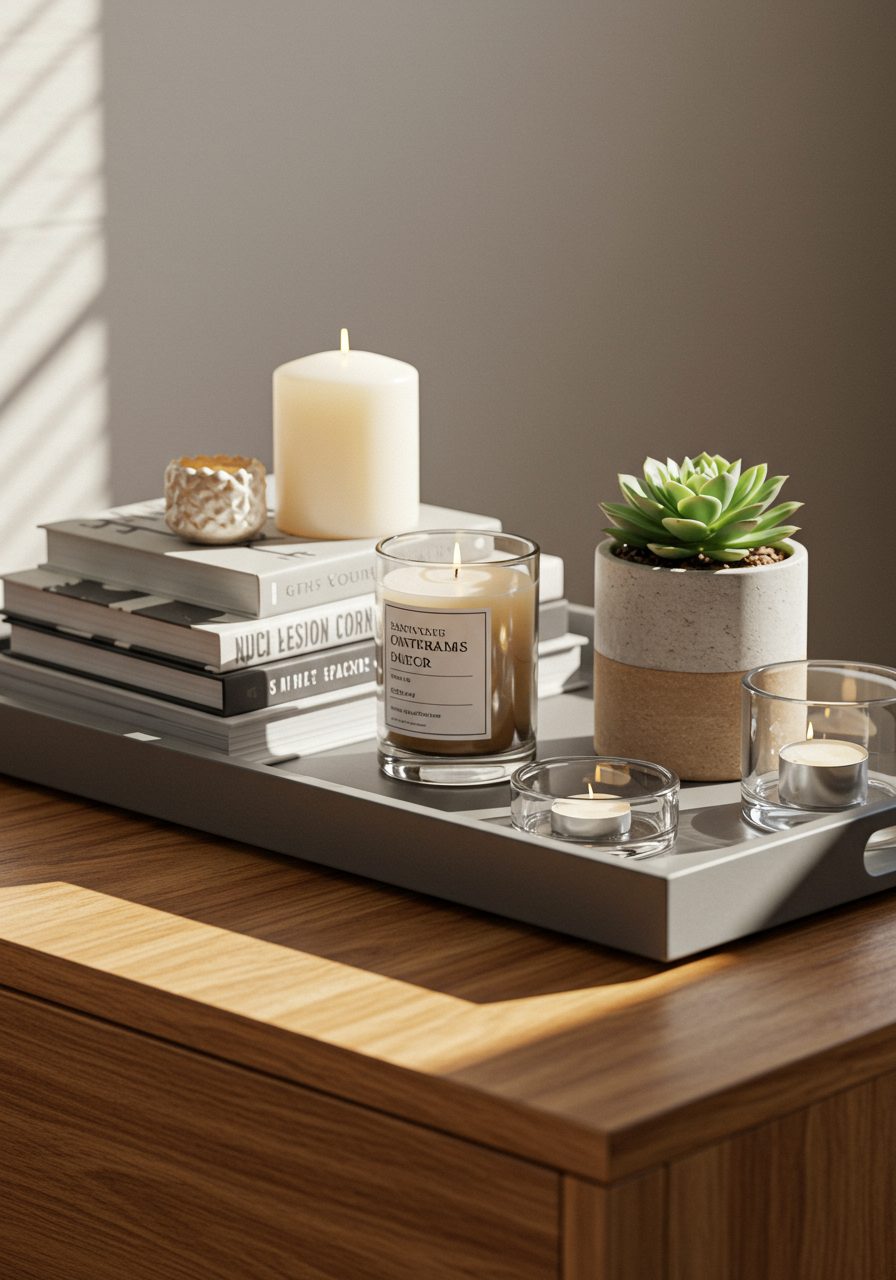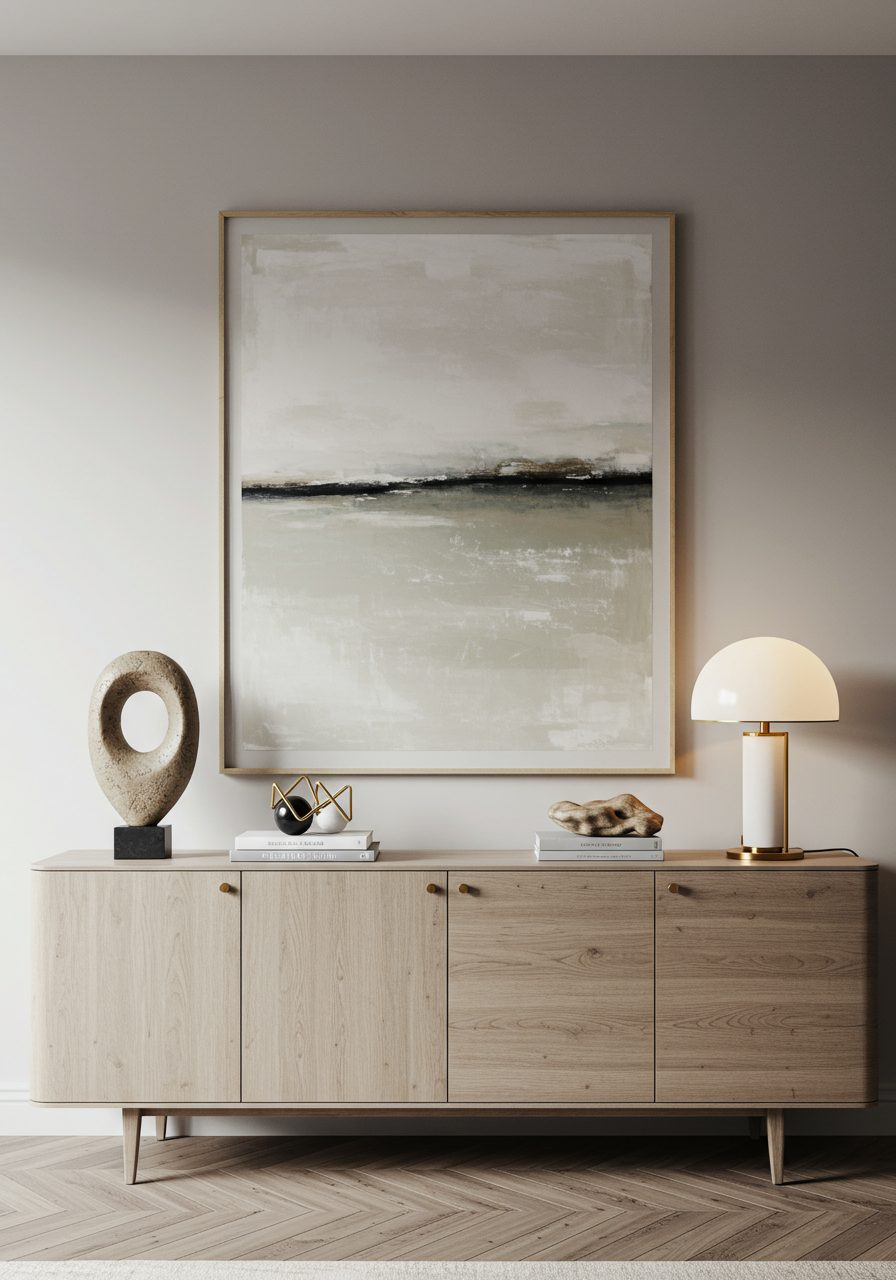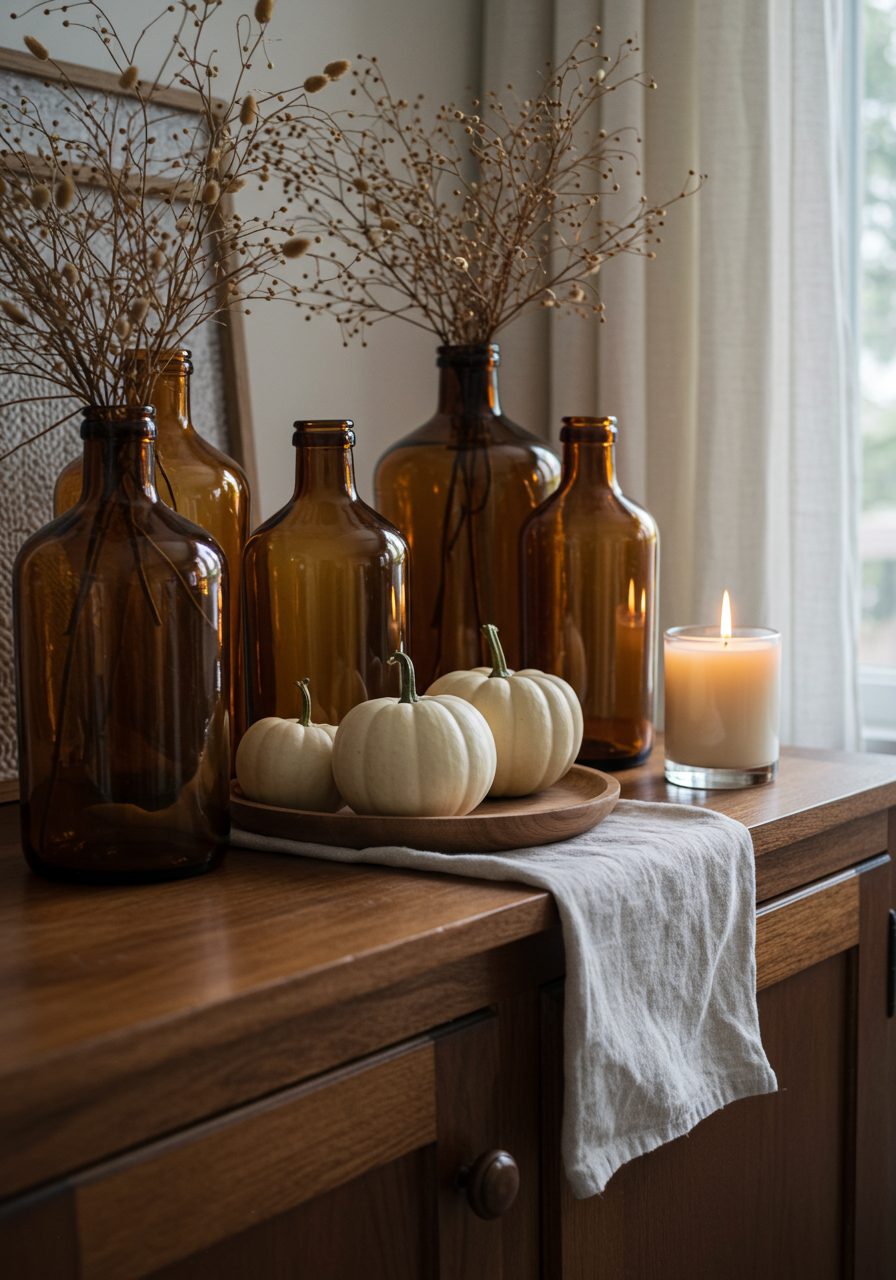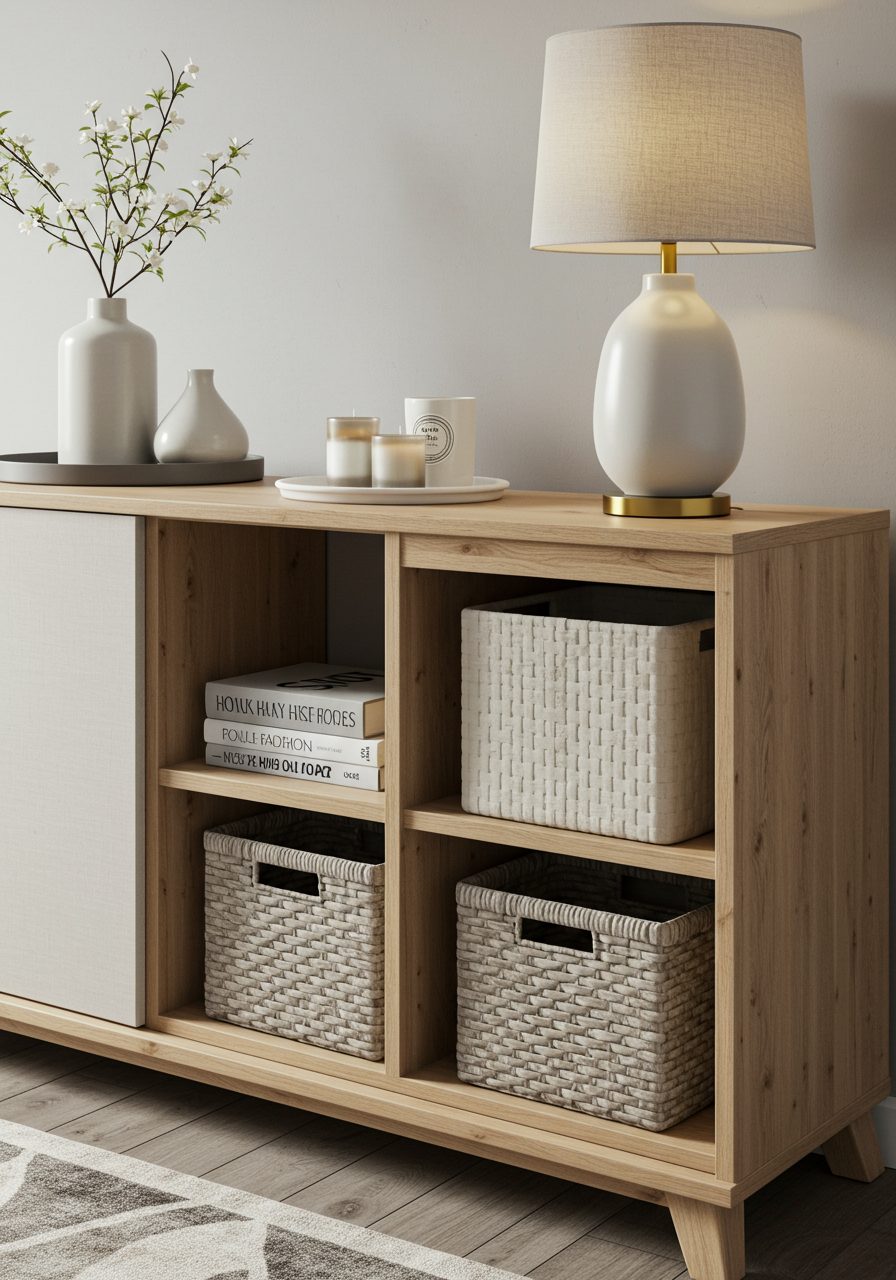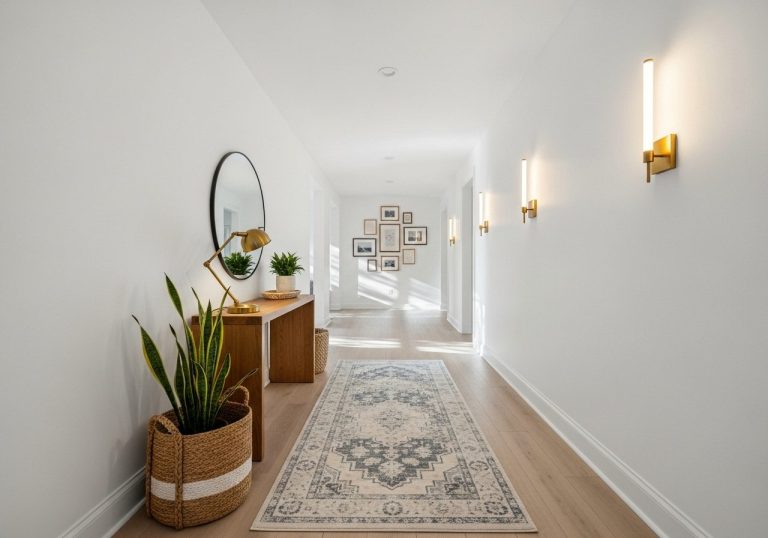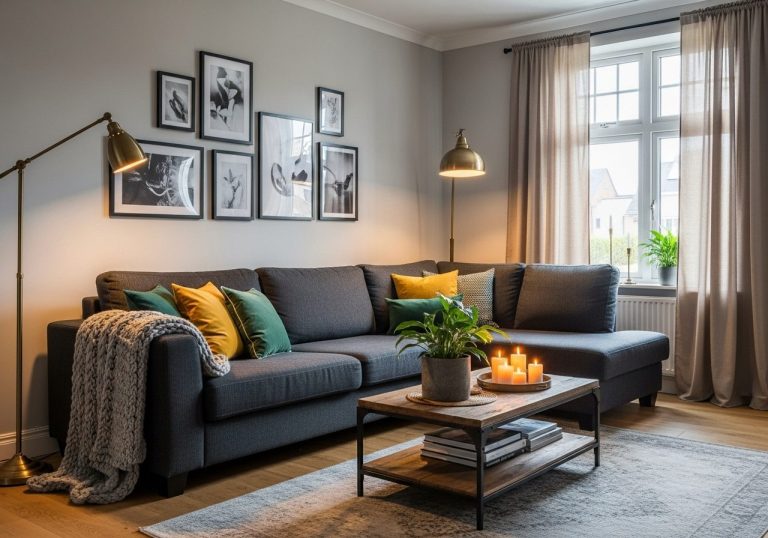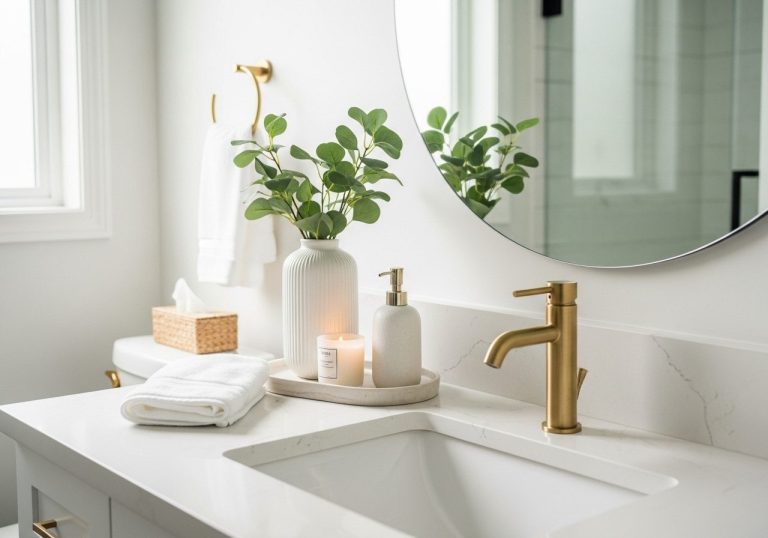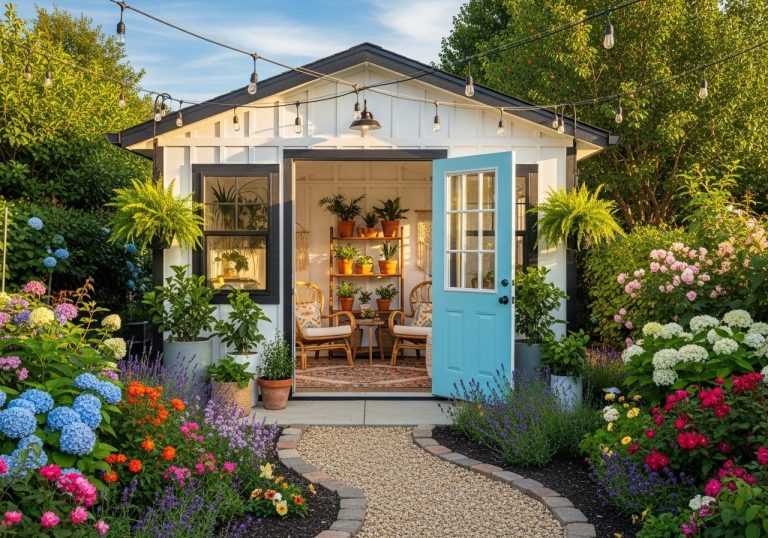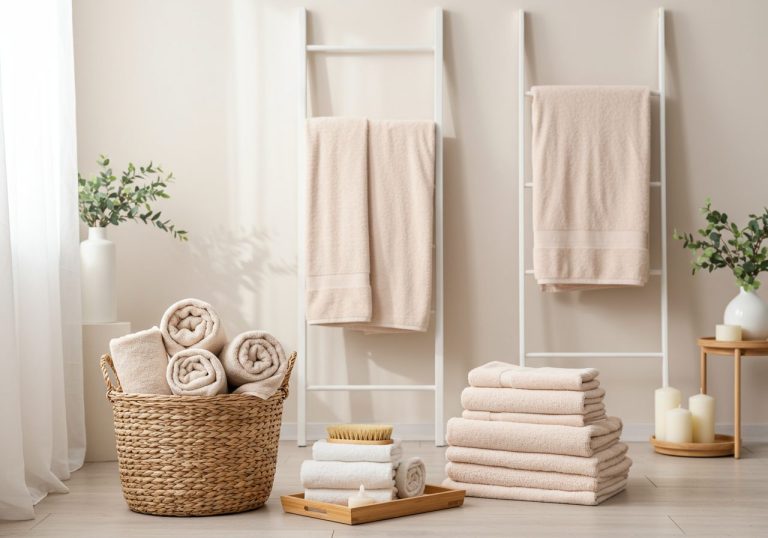How to Decorate a Sideboard in a Living Room: Stylish Tips That Make a Statement
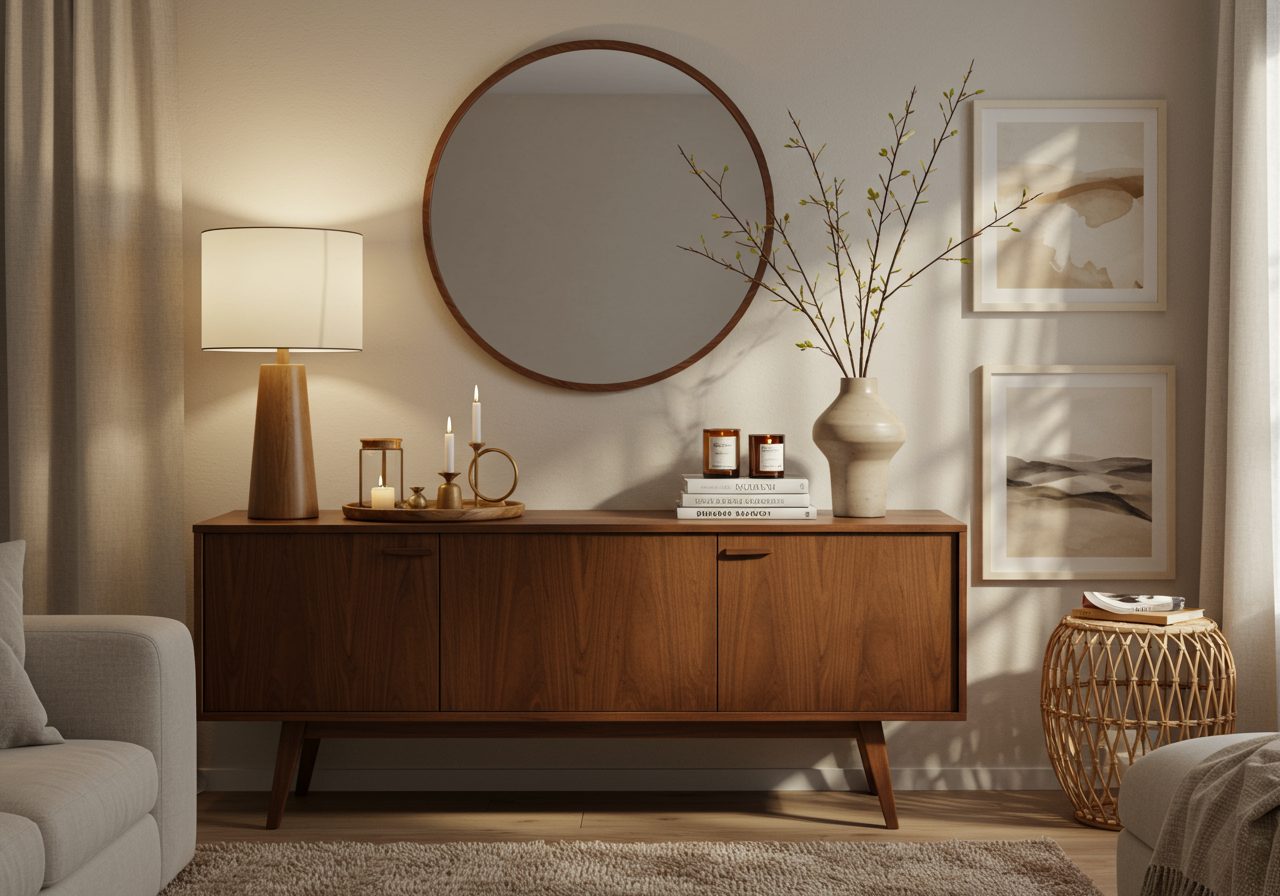
Table of Contents
- 1. Choose the Right Location for Your Sideboard
- 1.1. Key tips
- 2. Define the Purpose: Storage, Style, or Both?
- 3. Layer Decor Objects with Varying Heights
- 3.1. Mix Tall and Short Elements
- 3.2. Create a Focal Point
- 3.3. Rule of Threes
- 4. Incorporate Artwork or Mirrors Above the Sideboard
- 4.1. Options
- 5. Add Ambient or Task Lighting
- 5.1. Table Lamps
- 5.2. Wall Sconces
- 5.3. Accent Lighting
- 6. Use Trays to Anchor Small Objects
- 6.1. Why trays matter:
- 6.2. What to put on trays:
- 7. Incorporate Nature with Plants or Flowers
- 7.1. Best options for living rooms:
- 8. Style with Personal or Seasonal Items
- 8.1. Personal items that work well:
- 9. Combine Closed and Open Storage
- 9.1. If your sideboard has open cubbies or glass doors:
- 10. Choose a Cohesive Color Palette
- 10.1. Tips
- 11. Use Textures for Visual Depth
- 11.1. Textures to combine
- 12. Common Styling Mistakes to Avoid
- 12.1. Overcrowding
- 12.2. Wrong Scale
- 12.3. Ignoring Vertical Space
- 12.4. Clashing Styles
- 13. Frequently Asked Questions
- 13.1. What should I put on top of my sideboard in the living room?
- 13.2. How do I decorate a sideboard without clutter?
- 13.3. Can I put a TV on a sideboard in the living room?
- 13.4. What is the rule of thirds in sideboard styling?
- 13.5. Is a mirror or art better above a sideboard?
- 14. Final Thoughts on Decorating a Sideboard in a Living Room
When styled right, a sideboard can become a stunning centerpiece that ties together your living room decor. Whether you're aiming for minimalism or a bold statement, your sideboard can reflect your personal style while serving practical storage purposes.
Key Takeaways:
- Strategic placement enhances room flow and visibility.
- Use visual layering to create height and balance.
- Mix art, lighting, trays, and personal items for depth and personality.
- Keep styling functional with storage-conscious choices.
- Embrace seasonal rotation to refresh the look effortlessly.
Choose the Right Location for Your Sideboard
A well-placed sideboard enhances both function and form in your living room layout. Consider:
- Against an accent wall: Allows the decor above (mirror/art) to shine.
- Near a dining area: Useful if you're using it as a buffet or bar setup.
- Below a window or artwork: Ideal for balancing wall height with surface display.
Key tips
- Avoid blocking pathways or entry points.
- Leave at least 30 inches of clearance in front for walking space.
- Ensure it's visible from seating areas to create visual interest.
Define the Purpose: Storage, Style, or Both?
Before you decorate, clarify: will your sideboard be functional, decorative, or both?
| Purpose | Style Approach | Examples |
|---|---|---|
| Purely Decorative | Open surface, artwork, styling objects | Candle groupings, ceramics |
| Storage-Focused | Baskets, drawers, hidden organization | Tableware, tech accessories |
| Mixed Use | Combo of surface decor + functional cabinets | Bar setup + books + trays |
Pro tip: Use the top surface for display and the inside for clutter-free storage.
Layer Decor Objects with Varying Heights
Layering is crucial for creating visual flow. Avoid lining items flat across the surface.
Mix Tall and Short Elements
- Tall items: vases, lamps, branches
- Medium height: books, trays, candles
- Short items: coasters, small planters
Create a Focal Point
Every styled sideboard needs an “anchor” – the visual centerpiece.
Examples:
- A tall lamp on one side
- A framed art piece centered above
- A sculptural object like a bust or globe
Rule of Threes
Group objects in odd numbers (3 or 5) for a more natural visual balance.
| Tip | Why it works |
|---|---|
| Use odd numbers | Feels organic, less rigid |
| Vary object shapes | Adds dynamic energy |
| Anchor with tray | Grounds the group visually |
Incorporate Artwork or Mirrors Above the Sideboard
What goes above your sideboard is just as important.
Options
- Large framed artwork: Choose a size around ⅔ the width of the sideboard.
- Gallery wall: Curate 3–5 framed pieces of different sizes.
- Round mirror: Adds light and balances boxy shapes.
| Option | Best For | Style Tip |
|---|---|---|
| One Large Art Piece | Modern, minimal rooms | Frame with matte border |
| Round Mirror | Smaller or dark rooms | Reflects more light |
| Art Shelf | Seasonal stylers | Easy to rotate pieces |
Avoid placing art too high — keep the bottom edge ~6–10 inches above the top of the sideboard.
Add Ambient or Task Lighting
A sideboard is the perfect place to introduce cozy lighting to your living room.
Table Lamps
- A single statement lamp for a clean look
- Two smaller matching lamps for symmetry
Wall Sconces
- Great if the sideboard is narrow
- Keeps surface clear
Accent Lighting
- Use LED strips or puck lights under floating shelves or behind mirrors
| Type | Mood | Practical Use |
|---|---|---|
| Warm Edison bulbs | Cozy, vintage | Evening relaxation |
| White LEDs | Crisp, clean | Daytime brightness |
| Dimmable options | Flexible | Mood control |
Lighting should be functional but also aesthetic — light objects like glass, metallics, or plants for a glowing effect.
Use Trays to Anchor Small Objects
Trays are your best friend in styling a sideboard.
Why trays matter:
- Contain and organize small objects
- Prevent clutter from “floating”
- Add an extra layer of material (metal, rattan, wood)
What to put on trays:
- Candle trio
- Mini stack of books
- Coasters
- Tiny bud vase
- Remote controls or keys (if used functionally)
| Tray Shape | Best Used For |
|---|---|
| Rectangular | Linear displays, long sideboards |
| Round | Soften angular rooms |
| Mirrored | Reflect light, glam feel |
Pairing a tray with a tall item like a vase and a low item like a dish helps balance height.
Incorporate Nature with Plants or Flowers
A sideboard without something organic can feel cold or sterile. Add life with plants or flowers.
Best options for living rooms:
- Snake plant – tall, structured, low maintenance
- Pothos vine – trailing shape adds movement
- Succulents – compact, ideal for tray setups
- Fresh florals – change weekly for a fresh feel
Use decorative pots that match your room’s palette (e.g. ceramic, matte black, woven baskets).
| Plant Type | Visual Impact | Care Level |
|---|---|---|
| Snake Plant | Tall, vertical | Very Low |
| Pothos | Flowing greenery | Low |
| Succulents | Small and sculptural | Minimal |
| Seasonal Flowers | Fresh and vibrant | Moderate |
Position greenery at the ends or corners of the sideboard, or layer into a tray.
Style with Personal or Seasonal Items
Your sideboard should tell a story — yours.
Personal items that work well:
- Stacked books with beautiful covers
- Framed photos in matching frames
- Travel souvenirs or small sculptures
To keep things fresh, incorporate seasonal decor.
| Season | Suggested Styling |
|---|---|
| Fall | Pumpkins, amber glass, pinecones |
| Winter | Pine garlands, fairy lights, snow globes |
| Spring | Tulips, pastel candles, ceramic bunnies |
| Summer | Seashells, citrus bowls, palm prints |
Use just 1 or 2 themed items to avoid looking like a store display.
Combine Closed and Open Storage
Balance practical storage with design by mixing closed cabinets and open display shelves.
If your sideboard has open cubbies or glass doors:
- Add woven or linen baskets for hiding mess
- Store books spine-in for a clean look
- Use glass jars for collections (wine corks, matchbooks, etc.)
Use the closed section to stow:
- Chargers
- Candles
- Paper goods
- Board games
| Storage Type | Best Use | Styling Tip |
|---|---|---|
| Woven Basket | Loose items | Neutral color tones |
| Glass Cabinet | Display glassware | Use internal lighting |
| Hidden Drawer | Electronics | Keep cables tucked away |
Open shelves can be stylish only when they’re tidy.
Choose a Cohesive Color Palette
For a harmonious look, match your sideboard styling with your room’s core palette.
Tips
- Stick to 2–3 main colors + 1 accent
- Pull colors from rug, curtains, or wall art
- Use contrast: dark sideboard with light objects, or vice versa
| Room Style | Color Palette Example |
|---|---|
| Minimalist | White, beige, black accent |
| Boho | Terracotta, cream, olive |
| Modern | Black, walnut, metallic gold |
| Coastal | Soft blue, driftwood, linen |
Consistency doesn’t mean monotony — vary the textures and shapes even within a limited palette.
Use Textures for Visual Depth
Mixing materials is what takes a sideboard from flat to fabulous.
Textures to combine
- Wood grain (base furniture)
- Stone or marble (coasters, trays)
- Ceramics (vases)
- Textiles (linen runner, macramé fringe)
- Glass or crystal (candle holders)
Even if your color scheme is neutral, texture adds complexity and warmth.
| Texture | Adds | Use For |
|---|---|---|
| Linen | Softness | Table runner |
| Wicker | Natural feel | Storage baskets |
| Marble | Sophistication | Coasters/trays |
| Brushed Metal | Modernity | Lamp bases |
Layering rough and smooth finishes creates tactile variety — your eyes will notice.
Common Styling Mistakes to Avoid
Even beautiful sideboards can feel “off” due to common styling errors.
Overcrowding
- Solution: Stick to 5–7 items max
- Leave negative space for balance
Wrong Scale
- Tiny items get lost on a long surface
- Use at least one item that’s 18–24″ tall (lamp, vase)
Ignoring Vertical Space
- Use the wall above: hang art or mirrors
- Try a shelf riser for height layering
Clashing Styles
- Don’t mix too many motifs (e.g. rustic + glam + boho)
- Choose a dominant design direction and repeat elements
| Mistake | What It Causes | Easy Fix |
|---|---|---|
| Too much decor | Visual clutter | Edit monthly |
| Tiny objects only | Looks unfinished | Add height |
| Random colors | Incohesive look | Use color scheme |
Frequently Asked Questions
What should I put on top of my sideboard in the living room?
A balanced mix of functional and decorative objects:
- A tray with candles
- A lamp or small sculpture
- Framed art or a mirror above
- A touch of greenery
How do I decorate a sideboard without clutter?
Follow these steps:
- Choose a color palette
- Group items in odd numbers
- Use trays to anchor small items
- Avoid placing objects in a single flat line
- Leave some open space
Can I put a TV on a sideboard in the living room?
Yes — as long as:
- The TV base fits the depth and width
- You anchor decor around it (lamps, speakers)
- Cables are managed inside or behind
What is the rule of thirds in sideboard styling?
It’s a visual design rule: Divide your sideboard into 3 imaginary sections.
- Anchor each third with one key item
- Use height variation (e.g. tall → short → medium)
- Ensures a balanced, non-repetitive layout
Is a mirror or art better above a sideboard?
Depends on your goal:
- Mirror: Ideal for small or dark rooms; reflects light
- Art: Adds personality and a style statement
If you already have a lot of decor in the room, opt for a simple mirror to open it up.
Final Thoughts on Decorating a Sideboard in a Living Room
Decorating a sideboard in your living room isn't just about filling space — it's about curating a cohesive, balanced, and personalized display that elevates your room’s overall design.
- Start by choosing the right location, ensuring your sideboard complements the room layout and doesn’t block traffic flow.
- Define its primary purpose, whether it's for functional storage, visual style, or a mix of both.
- Master the art of layering decor objects with height variations, using the rule of thirds to guide visual balance.
- Don’t overlook the wall above — incorporating artwork or mirrors adds depth and anchors your styling.
- Add lighting to enhance ambiance and functionality, whether through table lamps, sconces, or accent lighting.
- Use trays to group small objects and create structured visual zones.
- Introduce plants or florals to bring life and movement, balancing hard surfaces with soft, organic forms.
- Personalize your sideboard with seasonal or meaningful items, allowing it to evolve throughout the year.
- Combine open and closed storage to keep things practical yet stylish.
- Stick to a cohesive color palette to ensure your decor complements the rest of the room.
- Add textures like wood, metal, linen, and ceramics to create a layered and inviting surface.
- Finally, avoid common mistakes like overcrowding, ignoring scale, and mismatching styles. Focus on thoughtful arrangement and intentional design.
When styled well, your sideboard becomes a statement piece that draws the eye, tells your story, and enhances the comfort and beauty of your living room.

